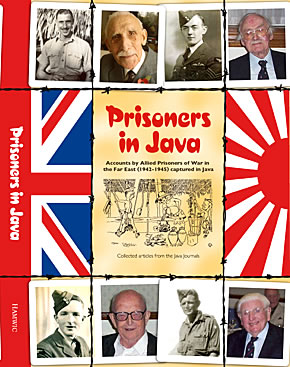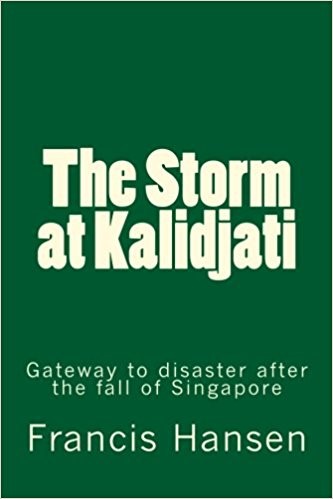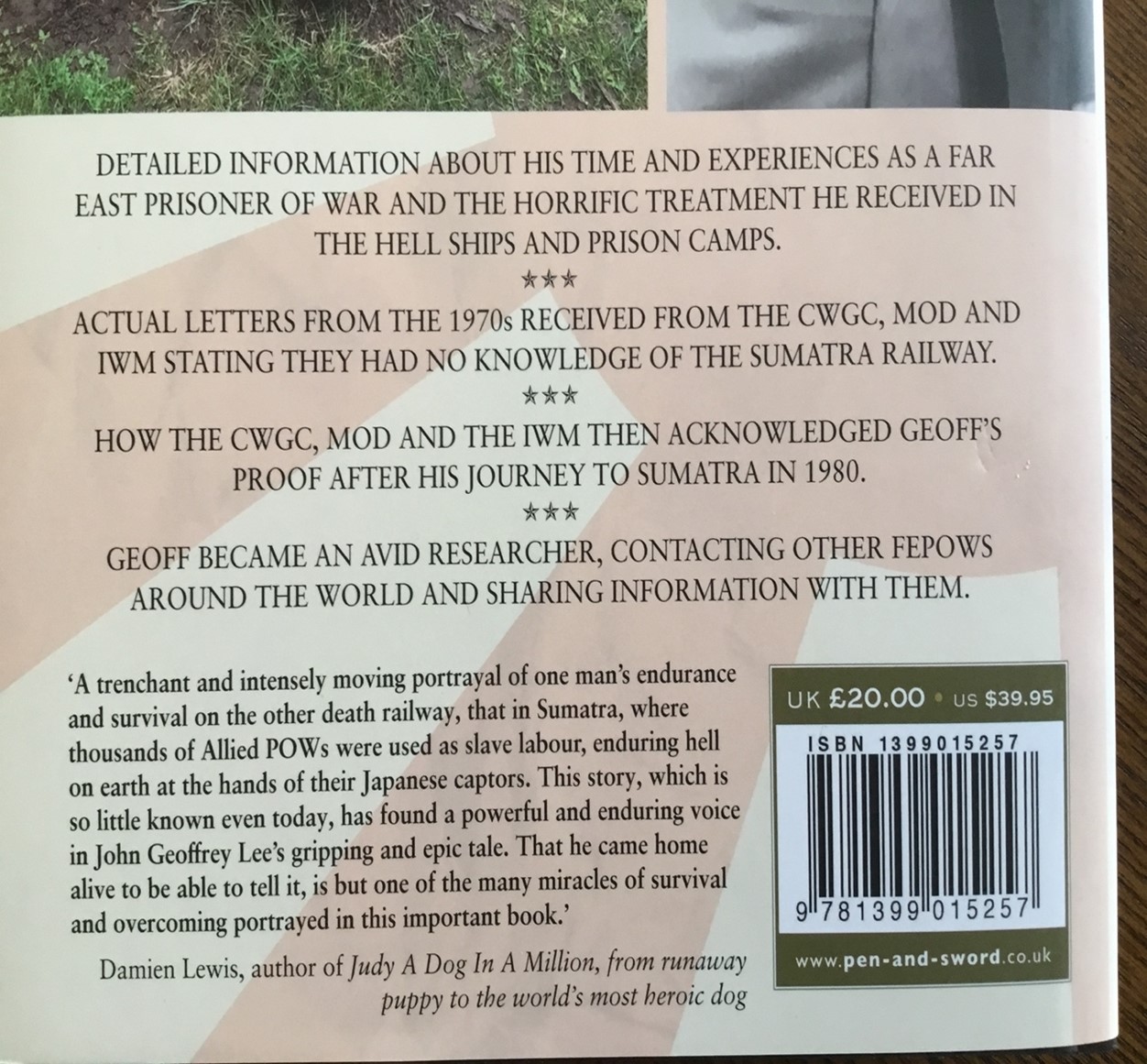

Funded by the National Lottery through Awards for All.
Prisoners in Java
Accounts by Allied Prisoners of War in the Far East (1942-1945) captured in Java
Thousands of British Servicemen were sent to the Far East in 1941 and 1942 as part of the Allied Forces defence of these territories against the Japanese.
 With minimal military back-up there was to be no ‘Dunkirk’ for the unfortunate men left defending Java, the ‘last bastion’ after Singapore had fallen.
With minimal military back-up there was to be no ‘Dunkirk’ for the unfortunate men left defending Java, the ‘last bastion’ after Singapore had fallen.
Following the Dutch capitulation of Java on the 8th March 1942 they all became prisoners of the Japanese, many of whom had only just arrived on the island.
As POWs they were ultimately deployed as Japanese slave labour on Java itself, in other more remote parts of the Dutch East Indies, on the Thai/Burma and Sumatra Railways and also the Japanese homelands.
The abhorrent conditions in the camps in which the prisoners were held, along with the starvation, deprivation and brutality by their captors, are indescribable to anyone who did not experience this hell. The inhumane method of transportation of drafts between these camps gave little respite, these becoming aptly known as the ‘Hellships’.
Thousands of men did not return, but many of those that did continued the strong comradeship borne out of adversity by forming clubs.
One such club is The Java Club 1942, whose members over the years have filled their Java Journal with their recollections and personal accounts. This book is a compilation of these articles which illustrate the horror and despair, as well as some of the more humorous moments of their three and a half years in captivity.
Over 336 pages and 140 maps & illustrations!
To view a selection of the book's introductory pages, including the Contents, Foreword and Acknowledgements pages, click here (636 kb PDF file*).
To view the book's Index, click here (116 kb PDF file*).
The book is available for £20 each, plus UK postage & packaging of £5 per copy. To order copies, click here to view, download and print an Order Form (397 kb PDF file*). Please fill this out and return with a cheque for the appropriate amount to the address on the form.
Sumatra's Fittest

This is a fascinating memoir of David Spero who was with the RAF, captured on Java and spent time in Boie Glodok, Tandjong Priok and Cycle Camp before being sent to Sumatra in May 1944 to work on the Pakanbaroe railroad.
Apart from learning about World War II history in the Far East, David Spero's memoir includes post war experiences of adapting to life afterwards and has lessons for us all, in how to approach life today and tomorrow.
The Spero family are kindly donating all proceeds from the book to the Java FEPOW 1942 Club. To obtain a copy, please visit www.amazon.co.uk where it is for sale currently at £12.99 and a Kindle version at £5.99. For other information, please contact David Spero's son Tony at antspero@gmail.com
THE STORM AT KALIDJATI: GATEWAY TO DISASTER AFTER THE FALL OF SINGAPORE BY FRANCIS HANSEN - THE BATTLE FOR SUMATRA & JAVA

New member Bridget Pollard has recently published this detailed, highly researched, book based around her father's experiences and that of the 49th Bty, 48th LAA. It covers the 48th LAA prior to embarkation, WS14 convoy to the Far East, fighting on Sumatra and Java to capitulation and the little known story will be of great interest to most of our members!
This book follows the course of the post-Singapore campaign from its beginnings to the bitter end, woven around the story of 49th Bty, 48th LAA Regiment and other Royal Artillery units, to show how politics and military commands affected both ends of the scale, top to bottom, from the General to the Gunner, from the Brigadier to the Bombadier.
What happened is often told in their own words and almost always taken from contemporary accounts. It is the true story of the fiasco in the Far East following the Allies' first attempt to set up a joint command to stop the all-conquering Japanese, as first Hong Kong, then Malaya, Singapore and the Philippines fell before them. It was impossible to resource properly from the start and ABDACOM's collapse left thousands of British and Australian personnel on the island of Java with orders to fight to the last man and the last bullet. The magic carpet out was only available for a select few. The senior officers who had staffed ABDACOM generally departed, and officers and men with particular skills or abilities that the Allies desperately needed were shipped away as the Japanese net closed around Java. Generally those left behind were those who were 'expendable'. They were left under the command of the colonial Dutch commanders, men who had never expected nor been trained to deal with such a situation. Their defence plan for the island had two parts. Firstly to try to use what ships and aircraft they had to stop the Japanese landing on Java in the first place. The second (post-invasion) plan was based on the assumption that there were only two beaches where the Japanese might land. Given this, the Allied forces would undertake a fighting retreat to delay the invaders, so that any relief force that might be around would have time to turn up. Failing this, the 'last stand' would be around the city of Bandoeng in the mountainous central spine of the island. As plans go it was not particularly ambitious but, given the circumstances and the forces at their disposal, it was the best they could do. Unfortunately, they also landed on a third beach, only forty miles away by good roads from Kalidjati, one of the two major airbases on the island. It should have been obvious that such a facility so close to the coast would be a prime target for the enemy. There was plenty of room there for their fighter and bomber aircraft and they could destroy the puny defence forces on Java within days. And the airfield was also only a few miles from a road leading to Bandoeng; a shorter route to the one the Dutch commanders hoped the invaders would take. If the Japanese took Kalidjati, the whole defence plan would be in ruins. The loss of Kalidjati is the centrepiece and climax of this book.
Kalidjati was where it all went wrong and with Kalidjati lost, Java was doomed. What happened there on 1st March 1942 was a 'perfect storm' when everything that could go wrong, did go wrong. It was a microcosm of the chaotic campaign that followed the fall of Singapore: a hostile climate, no knowledge of the local language, no orders or intelligence from above, lack of essential equipment, stores and ammunition, and incompetence, indecisiveness and inadequate communications at all levels. Many men paid a terrible price for their superiors' failings in the flash flood that swept through the airfield that day.
Not only will this book be of great interest to most of our members, the author, Bridget (her real name) has kindly offered to donate some of the proceeds from the book to The Java FEPOW Club! It is currently for sale on Amazon for £12.95
THE FORGOTTEN SQUADRON - THE 3RD KING'S OWN HUSSARS

We have been contacted by Brian Williams, who was researching his late father in law, FEPOW, Alfred Thomas Hall, a pre-war regular soldier captured in Java when his unit, B Squadron 3rd The Kings Own Hussars, were forced to capitulate. The project then widened to include, as far as possible, all members of B Squadron, and ultimately became the outline of his new book. He tells us ..
The 3rd Hussars had fought in North Africa from August 1940 through to the autumn of 1941 including B Squadron being left in Tobruk during the first siege from April to September 1941 and C Squadron deployed to defend Crete. The Regiment moved to Cyprus but were then ordered to provide a Squadron to deploy to Singapore to help defend the island from the Japanese.
The book covers the period from when B Squadron left Cyprus in January 1942. They never reached Singapore and were instead ordered to Sumatra and then on to Java after Sumatra was invaded. The book is my attempt to follow all the Squadron members from the time they were made prisoners on Java in March 1942 to their release in September 1945. It includes pen pictures of each of the men and what happened to them during their captivity, listing camps, hell-ships and deaths, whenever I have been able to find the information.
The 3rd The King's Own Hussars can trace their history back to 1865 and shortly afterwards took the title "The Queen Consort's Regiment of Dragoons". In 1714 the title changed to the "King's Own Regiment of Dragoons" and in 1818 they became "3rd The King's Own Light Dragoons". In 1861 the title of the regiment changed to "The 3rd King's Own Hussars".
During the First World War from 1914 to 1918 the regiment served in northern France and Flanders where they gained twenty-seven Battle Honours.
In 1921 the regiment changed its title for the last time to become the "3rd The King's Own Hussars".
From August 1940 to November 1941, the regiment saw active service in North Africa and Crete and in January 1942 'B' Squadron were sent to help stem the Japanese advance in the Far East. The story of what happened to the Squadron in the Far East forms the basis for this book
In 1958 the regiment amalgamated with the 7th Queen's Own Hussars to form "The Queen's Own Hussars" thus ending two hundred and seventy three years of unbroken service to the Crown.
It is hoped that this story will be of assistance to those with an interest in military history or to those researching their own family trees.
Nec Aspera Terrent [Hardships do not deter us]
If you wish to order a copy of the book it is available on Amazon, but Brian has kindly agreed that he will make a donation to The Java FEPOW Club for any copies ordered directly from him.
You can email Brian on ocsservices@btinternet.com or write to him at 32 Springfield Glade, Malvern, Worcs WR14 1LN and send a cheque, payable to Brian Williams for £14.99 (including mainland UK postage). Please mention The Java FEPOW Club.
POW ON THE SUMATRA RAILWAY


John Geoffrey Lee, (always known as Geoff), joined the RAF as ground crew, on his 20th birthday in June 1941. Little did he know what the war had in store for him and how it would affect the whole of his life. When he left Liverpool on a troop ship he eventually arrived in Java, where he was captured by the Japanese, along with many others.
During the next two years he survived many inhuman prison camps in Java, Ambon, Singapore and three terrifying hell ship journeys. From Singapore he was on a ferry which blew up and then was washed ashore in Sumatra and recaptured. Here began the sheer hell, as a slave on the Sumatra Railway which became a fete of survival for everyone. Geoff survived, weighing just 6 stone when he arrived back in Liverpool in December 1945.
Back home he had difficulty in convincing people where he had been, as no one had heard of the “Sumatra Railway” only the other one, thousands of miles away in Burma. Letters to newspapers were returned as ‘just another Burma Railway story’.
The Ministry of defence, Commonwealth War Graves Commission, and The Imperial War Museum, had no records of POW’s building a railway in Sumatra. So began Geoff’s journey, his aim, to prove to the establishment and other Far East Prisoners of War, what he already knew to be true.
This book which he wrote in the 1990’s, is Geoff’s’ amazing true story of his captivity, release, and subsequent lifelong efforts which led him to achieve recognition for the survivors of the Sumatra Railway and those who never made it back.
The book and Kindle version can be ordered from Pen and Sword, Amazon.co.uk and most online book sellers.